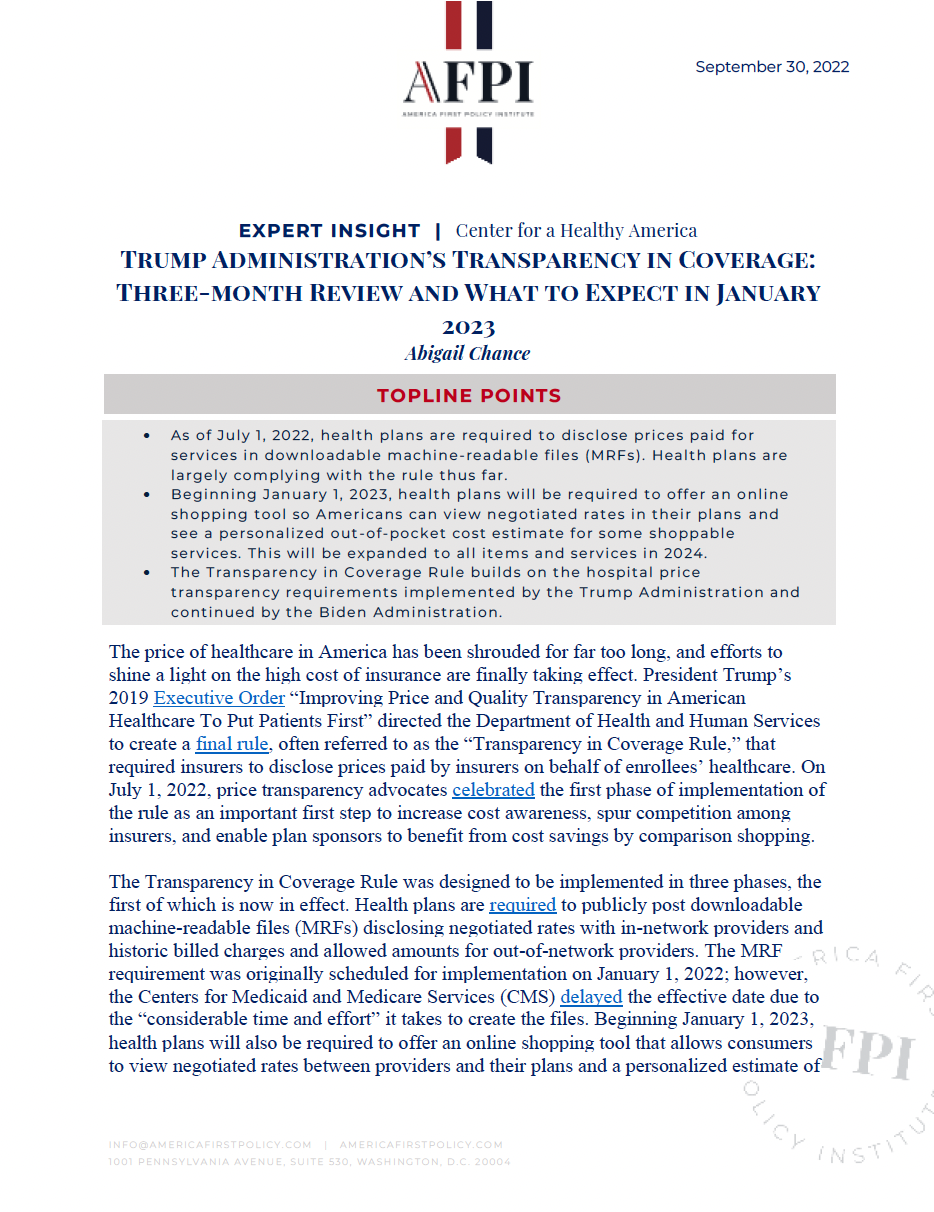Trump Administration’s Transparency in Coverage: Three-month Review and What to Expect in January
Key Takeaways
As of July 1, 2022, health plans are required to disclose prices paid for services in downloadable machine-readable files (MRFs). Health plans are largely complying with the rule thus far.
Beginning January 1, 2023, health plans will be required to offer an online shopping tool so Americans can view negotiated rates in their plans and see a personalized out-of-pocket cost estimate for some shoppable services. This will be expanded to all items and services in 2024.
The Transparency in Coverage Rule builds on the hospital price transparency requirements implemented by the Trump Administration and continued by the Biden Administration.
The price of healthcare in America has been shrouded for far too long, and efforts to shine a light on the high cost of insurance are finally taking effect. President Trump’s 2019 Executive Order “Improving Price and Quality Transparency in American Healthcare To Put Patients First” directed the Department of Health and Human Services to create a final rule, often referred to as the “Transparency in Coverage Rule,” that required insurers to disclose prices paid by insurers on behalf of enrollees’ healthcare. On July 1, 2022, price transparency advocates celebrated the first phase of implementation of the rule as an important first step to increase cost awareness, spur competition among insurers, and enable plan sponsors to benefit from cost savings by comparison shopping.
The Transparency in Coverage Rule was designed to be implemented in three phases, the first of which is now in effect. Health plans are required to publicly post downloadable machine-readable files (MRFs) disclosing negotiated rates with in-network providers and historic billed charges and allowed amounts for out-of-network providers. The MRF requirement was originally scheduled for implementation on January 1, 2022; however, the Centers for Medicaid and Medicare Services (CMS) delayed the effective date due to the “considerable time and effort” it takes to create the files. Beginning January 1, 2023, health plans will also be required to offer an online shopping tool that allows consumers to view negotiated rates between providers and their plans and a personalized estimate of out-of-pocket cost for 500 shoppable services and items. On January 1, 2024, these shopping tools will be required to show costs for the remaining items and services.
The MRFs contain coded data that is unfortunately incomprehensible to most Americans who are unfamiliar with this type of computer language. While this initial phase of implementation may not greatly benefit average consumers looking to comparison shop for next year’s plans, MRFs can be utilized by researchers and entrepreneurs capable of interpreting the files to inform the large entities that purchase group insurance. This is significant considering that half of Americans do not directly buy health insurance for themselves but rather enroll in a plan their employer chooses for them.
MRFs are being uploaded and analyzed by healthcare transparency companies such as Turquoise, Health, and Ribbon Health, who have developed software to gain meaningful insights into costs and coverage. Analysis of MRFs will help provide group plan sponsors, such as employers and associations, with price and claim payment information so they can compare the value of health plans and find better value for employees.
These transparency efforts also provide new information comparing the cost of care at different locations. Preliminary data from Turquoise Health (chart below) shows how much payer negotiated rates differ for the same services based on the type of facility. Of the entities in the chart, the average reported fee schedule rates at hospital outpatient settings versus ambulatory surgical centers (ASCs) for a diagnostic colonoscopy were $2,633.19 for hospital outpatient settings, compared to $649.25 for ASCs. This is a sizeable discrepancy in payment rates for an identical procedure and highlights where costs are the highest. It also demonstrates the potential benefit of site-neutral payments for procedures, a policy championed by the Trump Administration where insurance companies would reimburse one amount for a procedure regardless of if the procedure was performed in a hospital or ASC.
|
Source: Turquoise Health Real Time Payer Rates Data Tracker, https://blog.turquoise.health/turquoise-health-real-time-payer-rates-tracker/ |
Previous agency-led efforts to advance transparency have focused on hospital prices, stemming from the Trump executive order mentioned above. The hospital price transparency rule, which went into effect January 1, 2021, required hospitals to disclose prices for at least 300 shoppable services. Unfortunately, compliance has been an issue, and just 16% of hospitals were found to be compliant with these requirements one year after the rule took effect. CMS began to issue fines this June for hospitals in violation. States can lead on this issue by passing transparency laws to encourage better compliance.
Conversely, health plans seem to have largely complied with the Transparency in Coverage rule. The top ten largest insurance companies (by market share) operating in the U.S. have posted MRFs on their websites. Before the rule took effect, UnitedHealthcare, the largest insurer in the U.S., stated that it intended to comply with the requirements fully. Fines for noncompliance are hefty, at $100 per instance of noncompliance per day, meaning that an insurance company with 10,000 enrollees could be fined $1,000,000 per day for noncompliance. Broad compliance with transparency requirements is imperative to allow consumers the market-based benefits transparency brings, such as increased competition and greater consumer information.
Individual Americans can look forward to January 1, 2023, for a more consumer-friendly, internet-based shopping tool to be released on health plan websites. For now, MRFs are an important first step to gaining insight into healthcare costs, a crucial component of a health system that puts patients and doctors, rather than government and insurance bureaucrats, in charge.
